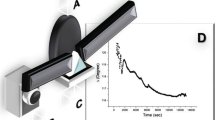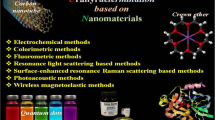Abstract
A new wireless sensing method for the detection of uranium in water samples has been reported in this paper. The method is based on a sandwich-type detection strategy. Salophen, a tetradentate ligand of uranyl ion, was immobilized on the surface of the polyurethane-protected magnetoelastic sensor as receptor for the capture of uranyl ion. The phosphorylated polyvinyl alcohol coated magnetic Fe3O4 nanoparticles were used as signal-amplifying tags of uranyl ion. In a procedure of determining uranium, firstly uranyl ion in sample solution was captured on the sensor surface. Then the captured uranyl bound the nanoparticle through its coordination with the phosphate group. The amount of uranium was detected through the measure of the resonance frequency shift caused by the enhanced mass loading on the sensor surface. A linear range was found to be 0.2–20.0 μg/L under optimal conditions with a detection limit of 0.11 μg/L. The method has been applied to determine uranium in environmental water samples with the relative standard deviations of 2.1–3.6 % and the recoveries of 98.0–101.5 %. The present technique is one of the most suitable techniques for assay of uranium at trace level in environmental water samples collected from different sources.




Similar content being viewed by others
References
Gonzalez JJ, Oropeza D, Mao X, Russo RE (2008) Assessment of the precision and accuracy of thorium (232Th) and uranium (238U) measured by quadrupole based inductively coupled plasma-mass spectrometry using liquid nebulization, and femtosecond laser ablation. J Anal Atomic Spectrom 23:229–234
Jamali MR, Assadi Y, Shemirani F, Hosseini MRM, Kozani RR, Masteri-Farahani M, Salavati-Niasari M (2006) Synthesis of salicylaldehyde-modified mesoporous silica and its application as a new sorbent for separation, preconcentration and determination of uranium by inductively coupled plasma atomic emission spectrometry. Anal Chim Acta 579:68–73
Kapsimalis R, Landsberger S, Ahmed YA (2009) The determination of uranium in food samples by Compton suppression epithermal neutron activation analysis. Appl Radiat Isot 67:2097–2099
Azam A, Prasad R (1989) Trace element analysis of uranium of soil and plant samples using fission track registration technique. J Radioanal Nucl Chem 133:199–202
Nachab A, Nourreddine A, Benjelloun M, Kihel S, Oster D, Pape A (2004) Uranium analysis of sediments by γ-ray spectrometry with corrections for self-absorption. Nucl Instrum Methods B 215:228–234
Ruan C, Luo W, Wang W, Gu B (2007) Surface-enhanced Raman spectroscopy for uranium detection and analysis in environmental samples. Anal Chim Acta 605:80–86
Ganesh S, Khan F, Ahmed MK, Pandey S (2010) Sequential determination of uranium(IV), free acidity and hydrazine in a single aliquot. J Radioanal Nucl Chem 286:33–37
Grimes CA, Roy SC, Rani S, Cai Q (2011) Theory, instrumentation and applications of magnetoelastic resonance sensors: a review. Sensors 11:2809–2844
Stoyanov PG, Grimes CA (2000) Remote query magnetostrictive viscosity sensor. Sens Actuators A 80:8–14
Cai QY, Grimes CA (2000) Remote query magnetoelastic pH sensor. Sens Actuators B 71:112–117
Grimes CA, Mungle CS, Zeng ZF, Jain MK, Dreschel WR, Paulose M, Ong KG (2002) Wireless magnetoelastic resonance sensors: a critical review. Sensors 2:294–313
He B, Liao L-F, Hu S-J, Gao S-Q, Xiao X-L (2009) Determination of trace mercury with catalytic precipitation wireless sensing method. Chin J Anal Chem 37:123–126
Du N, Liao L, Xiao Y, Xiao X, Zhao Z, Lin Y (2011) Determination of radon using solid state nuclear tracks wireless sensing method. Anal Chim Acta 686:121–125
Bouropoulos N, Kouzoudis D, Grimes C (2005) The real-time, in situ monitoring of calcium oxalate and brushite precipitation using magnetoelastic sensors. Sens Actuators B 109:227–232
Cai QY, Zeng KF, Ruan CM, Desai TA, Grimes CA (2004) A wireless, remote query glucose biosensor based on a pH-sensitive polymer. Anal Chem 76:4038–4043
Wu SH, Cai QY, Grimes CA (2006) Kinetic assay of trypsin with a wireless magnetoelastic sensor. Sens Lett 4:160–164
Ruan C, Zeng K, Varghese OK, Grimes CA (2004) A magnetoelastic bioaffinity-based sensor for avidin. Biosens Bioelectron 19:1695–1701
Wu S, Zhu Y, Cai Q, Zeng K, Grimes CA (2007) A wireless magnetoelastic α-amylase sensor. Sens Actuators B 121:476–481
Wu S, Gao X, Cai Q, Grimes CA (2007) A wireless magnetoelastic biosensor for convenient and sensitive detection of acid phosphatase. Sens Actuators B 123:856–859
He B, Liao L, Xiao X, Gao S, Wu Y (2009) Monitoring of Mycoplasma genitalium growth and evaluation of antibacterial activity of antibiotics tetracycline and levofloxacin using a wireless magnetoelastic sensor. Biosens Bioelectron 24:1990–1994
He B, Liao L, Xiao X, Gao S, Wu Y (2011) Detection of Mycoplasma genitalium using a wireless magnetoelastic immunosensor. Anal Biochem 408:1–4
Li S, Li Y, Chen H, Horikawa S, Shen W, Simonian A, Chin BA (2010) Direct detection of Salmonella typhimurium on fresh produce using phage-based magnetoelastic biosensors. Biosens Bioelectron 26:1313–1319
Xiao XL, Guo M, Li Q, Cai QY, Yao S, Grimes CA (2008) In-situ monitoring of breast cancer cell (MCF-7) growth and quantification of the cytotoxicity of anticancer drugs fluorouracil and cisplatin. Biosens Bioelectron 24:247–252
Zhao Z, Liao L, Xiao X, Du N, Lin Y (2011) Wireless sensing determination of uranium(IV) based on its inhibitory effect on a catalytic precipitation reaction. J Radioanal Nucl Chem 289:893–898
Zhao Z, Liao L, Xiao X, Du N, Lin Y (2013) Determination of uranium(VI) based on enzyme inhibition using a wireless magnetoelastic sensor. Int J Environ Anal Chem 93:613–622
Lin H, Chen Z, Lu Q, Cai Q, Grimes CA (2010) A wireless and sensitive sensing detection of polycyclic aromatic hydrocarbons using humic acid-coated magnetic Fe3O4 nanoparticles as signal-amplifying tags. Sens Actuators B 146:154–159
Lin H, Lu Q, Ge S, Cai Q, Grimes CA (2010) Detection of pathogen Escherichia coli O157:H7 with a wireless magnetoelastic-sensing device amplified by using chitosan-modified magnetic Fe3O4 nanoparticles. Sens Actuators B 147:343–349
Sessler JL, Melfi PJ, Pantos GD (2006) Uranium complexes of multidentate N-donor ligands. Coord Chem Rev 250:816–843
Cametti M, Ilander L, Rissanen K (2009) Recognition of Li+ by a salophen-UO2 homodimeric complex. Inorg Chem 48:8632–8637
Dalla Cort A, Pasquini C, Schiaffino L (2007) Nonsymmetrically substituted uranyl-salophen receptors: new opportunities for molecular recognition and catalysis. Supramol Chem 19:79–87
Cametti M, Nissinen M, Dalla Cort A, Mandolini L, Rissanen K (2007) Ion pair recognition of quaternary ammonium and iminium salts by uranyl-salophen compounds in solution and in the solid state. J Am Chem Soc 129:3641–3648
Cametti M, Nissinen M, Dalla Cort A, Mandolini L, Rissanen K (2005) Recognition of alkali metal halide contact ion pairs by uranyl-salophen receptors bearing aromatic sidearms. The role of cation-π interactions. J Am Chem Soc 127:3831–3837
Dalla Cort A, Forte G, Schiaffino L (2011) Anion recognition in water with use of a neutral uranyl-salophen receptor. J Org Chem 76:7569–7572
Ciogli A, Dalla Cort A, Gasparrini F, Lunazzi L, Mandolini L, Mazzanti A, Pasquini C, Pierini M, Schiaffino L, Mihan FY (2008) Enantiomerization of chiral uranyl-salophen complexes via unprecedented ligand hemilability: toward configurationally stable derivatives. J Org Chem 73:6108–6118
Dalla Cort A, Mandolini L, Schiaffino L (2008) The role of attractive van der Waals forces in the catalysis of michael addition by a phenyl decorated uranyl-salophen complex. J Org Chem 73:9439–9442
Rudkevich DM, Verboom W, Brzózka Z, Palys MJ, Stauthamer WPRV, Van Hummel GJ, Franken SM, Harkema S, Engbersen JFJ, Reinhoudt DN (1994) Functionalized UO2 salenes: neutral receptors for anions. J Am Chem Soc 116:4341–4351
Rudkevich DM, Stauthamer WPRV, Verboom W, Engbersen JFJ, Harkema S, Reinhoudt DN (1992) Uranyl UO2-salenes: neutral receptors for anions with a high selectivity for dihydrogen phosphate. J Am Chem Soc 114:9671–9673
Wojciechowski K, Wróblewski W, Brzózka Z (2003) Anion buffering in the internal electrolyte resulting in extended durability of phosphate-selective electrodes. Anal Chem 75:3270–3273
Kim J, Kang DM, Shin SC, Choi MY, Kim J, Lee SS, Kim JS (2008) Functional polyterthiophene-appended uranyl-salophen complex: electropolymerization and ion-selective response for monohydrogen phosphate. Anal Chim Acta 614:85–92
Wygladacz K, Qin Y, Wroblewski W, Bakker E (2008) Phosphate-selective fluorescent sensing microspheres based on uranyl salophene ionophores. Anal Chim Acta 614:77–84
Antonisse MMG, Snellink-Ruël BHM, Engbersen JFJ, Reinhoudt DN (1998) H2PO4-selective CHEMFETs with uranyl salophene receptors. Sens Actuators B 47:9–12
Wróblewski W, Wojciechowski K, Dybko A, Brzózka Z, Egberink RJM, Snellink-Ruël BHM, Reinhoudt DN (2000) Uranyl salophenes as ionophores for phosphate-selective electrodes. Sens Actuators B 68:313–318
Zhao M, Liao L, Wu M, Lin Y, Xiao X, Nie C (2012) Double-receptor sandwich supramolecule sensing method for the determination of ATP based on uranyl-salophen complex and aptamer. Biosens Bioelectron 34:106–111
Kim DK, Zhang Y, Voit W, Rao KV, Muhammed M (2001) Synthesis and characterization of surfactant-coated superparamagnetic monodispersed iron oxide nanoparticles. J Magn Magn Mater 225:30–36
Liu J, Zheng Y, Wang W, Wang A (2009) Preparation and swelling properties of semi-IPN hydrogels based on chitosan-g-poly(acrylic acid) and phosphorylated polyvinyl alcohol. J Appl Polym Sci 114:643–652
Zeng KF, Ong KG, Mungle C, Grimes CA (2002) Time domain characterization of oscillating sensors: application of frequency counting to resonance frequency determination. Rev Sci Instrum 73:4375–4380
Zeng KF, Grimes CA (2004) Threshold-crossing counting technique for damping factor determination of resonator sensors. Rev Sci Instrum 75:5257–5261
Kumar SA, Shenoy NS, Pandey S, Sounderajan S, Venkateswaran G (2008) Direct determination of uranium in seawater by laser fluorimetry. Talanta 77:422–426
Hedaya MA, Birkenfeld HP, Kathren RL (1997) A sensitive method for the determination of uranium in biological samples utilizing kinetic phosphorescence analysis. J Pharm Biomed Anal 15:1157–1165
Moulin C, Beaucaire C, Decambox P, Mauchien P (1990) Determination of uranium in solution at the ng L-1 level by time-resolved laser-induced spectrofluorimetry: application to geological samples. Anal Chim Acta 238:291–296
Acknowledgments
The authors thank the National Natural Science Foundation of China (NSFC Nos. 10975069, 11275091, 20877038) for financial support. The authors also thank Prof. Qingyun Cai (Hunan University, China) for the help with the wireless magnetoelastic-sensing device developed by Craig A. Grimes et al. (The Pennsylvania State University, University Park, USA).
Author information
Authors and Affiliations
Corresponding author
Electronic supplementary material
Below is the link to the electronic supplementary material.
Rights and permissions
About this article
Cite this article
Yang, M., Liao, L., Zhang, G. et al. Detection of uranium with a wireless sensing method by using salophen as receptor and magnetic nanoparticles as signal-amplifying tags. J Radioanal Nucl Chem 298, 1393–1399 (2013). https://doi.org/10.1007/s10967-013-2663-z
Received:
Published:
Issue Date:
DOI: https://doi.org/10.1007/s10967-013-2663-z




